Halocline Induced by Rainfall in Saline Water Ponds in the Tropics and Its Impact on Physical Water Quality
Abstract
:1. Introduction
2. Materials and Methods
2.1. Study Site and Pond Conditions
2.2. Monitoring of Pond Environment
2.3. Data Analysis
3. Results and Discussions
3.1. Variation of Weather, Water Temperature, and Salinity
3.2. Classification of Heat Storage Period and Non-Heat Storage Period by Change Point Analysis
3.3. Structure of Density Stratification
3.4. Characteristic Physical Water Quality Variation Divided into the Periods and Layers
3.5. Princpal Component Analysis for Observed Parameters
3.6. Mechanism of Different Water Quality Conditions during Heat Storage Period in Pond C
4. Conclusions
- The important trigger which could induce halocline formation in saline water ponds is rainfall. When rainfall can generate salinity stratification, halocline phenomena may occur in the pond.
- The condition of salinity stratification was confirmed by the vertical distribution of the Brunt–Väisälä frequency, , which expresses the stability of density stratification. When a halocline can occur in a water body, the vertical distribution of has a peak value at the middle height of the pond.
- The start/end timing of the heat storage could be estimated by change point analysis for the time-series data of the water temperature obtained in the lower layer.
- When a halocline forms in a saline water pond, heat can be stored in the lower high-salinity layer, due to the halocline insulation effect.
- With the appearance of a halocline, movements of turbidity, including micro-organisms between the lower and upper layers, are interrupted. As a result, the turbidity and DO distributions can change during the heat storage period.
Author Contributions
Funding
Institutional Review Board Statement
Informed Consent Statement
Data Availability Statement
Conflicts of Interest
References
- Ueda, S.; Kondo, K.; Chikuchi, Y. Effects of the halocline on water quality and phytoplankton composition in a shallow brackish lake (Lake Obuchi, Japan). Limnology 2005, 6, 149–160. [Google Scholar] [CrossRef]
- Velmurugan, V.; Srithar, K. Prospects and scopes of solar pond: A detailed review. Renew. Sustain. Energy Rev. 2008, 12, 2253–2263. [Google Scholar] [CrossRef]
- Date, A.; Yaakob, Y.; Date, A.; Krishnapillai, S.; Akbarzadeh, A. Heat extraction from Non-Convective and Lower Convective Zones of the solar pond: A transient study. Sol. Energy 2013, 97, 517–528. [Google Scholar] [CrossRef]
- Hull, J.R.; Nielsen, J.; Golding, P. Salinity Gradient Solar Ponds; CRC press: Boca Raton, FL, USA, 1988. [Google Scholar]
- Abdullah, A.A.; Fallatah, H.M.; Lindsay, K.A.; Oreijah, M.M. Measurements of the performance of the experimental salt-gradient solar pond at Makkah one year after commissioning. Sol. Energy 2017, 150, 212–219. [Google Scholar] [CrossRef]
- Sukhatme, S.P. Solar Energy: Principles of Thermal Collection and Storage, 4th ed.; McGraw-Hill Inc.: New York, NY, USA, 2017. [Google Scholar]
- Verma, S.; Das, R. Wall profile optimisation of a salt gradient solar pond using a generalized model. Sol. Energy 2019, 184, 356–371. [Google Scholar] [CrossRef]
- Angeli, C.; Leonardi, E. A one-dimensional numerical study of the salt diffusion in a salinity-gradient solar pond. Int. J. Heat Mass Transf. 2004, 47, 1–10. [Google Scholar] [CrossRef]
- Jeong, Y.-H.; Kwak, D.-H. Influence of external loading and halocline on phosphorus release from sediment in an artificial tidal lake. Int. J. Sediment Res. 2020, 35, 146–156. [Google Scholar] [CrossRef]
- Lougee, L.A.; Bollens, S.M.; Avent, S.R. The effects of haloclines on the vertical distribution and migration of zooplankton. J. Exp. Mar. Biol. Ecol. 2020, 278, 111–134. [Google Scholar] [CrossRef]
- Uurasjärvi, E.; Pääkkönen, M.; Setälä, O.; Koistinen, A.; Lehtiniemi, M. Microplastics accumulate to thin layers in the stratified Baltic Sea. Environ. Pollut. 2021, 268, 115700. [Google Scholar] [CrossRef] [PubMed]
- FAO. Fishery and Aquaculture Statistics. 2021 Global Aquaculture Production 1950–2019 (FishstatJ). In FAO Fisheries Division [online]; Rome. Updated 2021. Available online: www.fao.org/fishery/statistics/software/fishstatj/en (accessed on 25 April 2021).
- Oddsson, G.V. A Definition of Aquaculture Intensity Based on Production Functions—The Aquaculture Production Intensity Scale (APIS). Water 2020, 12, 765. [Google Scholar] [CrossRef] [Green Version]
- Boyd, C.E.; Tucker, C.S. Water Quality Requirements in Pond Aquaculture Water Quality Management; Springer Science & Business Media: Berlin/Heidelberg, Germany, 2012. [Google Scholar]
- Walker, P.J.; Winton, J.R. Emerging viral diseases of fish and shrimp. Vet. Res. 2010, 41, 51. [Google Scholar] [CrossRef] [PubMed] [Green Version]
- Lotz, J.M.; Anton, L.S.; Soto, M.A. Effect of chronic Taura syndrome virus infection on salinity tolerance of Litopenaeus vannamei. Dis Aquat Organ. 2005, 65, 75–78. [Google Scholar] [CrossRef]
- Peng, S.-E.; Lo, C.-F.; Liu, K.-F.; Kou, G.-H. The Transition from Pre-patent to Patent Infection of White Spot Syndrome Virus (WSSV) in Penaeus monodon Triggered by Pereiopod Excision. Fish Pathol. 1998, 33, 395–400. [Google Scholar] [CrossRef]
- Alonzo, K.H.F.; Cadiz, R.E.; Traifalgar, R.F.M.; Corre, V.L., Jr. Immune responses and susceptibility to Vibrio parahaemolyticus colonization of juvenile Penaeus vannamei at increased water temperature. AACL Bioflux 2017, 10, 1238–1247. [Google Scholar]
- Hargrea, J.A.; Tucker, S.C. Defining loading limits of static ponds for catfish aquaculture. Aquac. Eng. 2003, 28, 47–63. [Google Scholar] [CrossRef]
- Wyban, J.; Walsh, W.A.; Godin, D.M. Temperature effects on growth, feeding rate and feed conversion of the Pacific white shrimp (Penaeus vannamei). Aquaculture 1995, 138, 267–279. [Google Scholar] [CrossRef]
- Wang, N.; Xu, X.; Kestemont, P. Effect of temperature and feeding frequency on growth performances, feed efficiency and body composition of pikeperch juveniles (Sander lucioperca). Aquaculture 2009, 289, 70–73. [Google Scholar] [CrossRef]
- Ozaki, A.; Kaewjantawee, P.; Anongponyoskul, M.; Thinh, N.V.; Matsumoto, M.; Harada, M.; Hamagami, K.; Okayasu, T. Heat storage induced by salinity stratification in tropical saline aquaculture ponds. In Proceedings of the 2019 ASABE Annual International Meeting 2019, Boston, MA, USA, 7–10 July 2019; Volume 2019, p. 01005. [Google Scholar]
- Ozaki, A.; Kaewjantawee, P.; Anongponyoskul, M.; Thinh, N.V.; Matsumoto, M.; Harada, M.; Hamagami, K.; Okayasu, T. Field observation on heat storage phenomenon observed in tropical saline aquaculture ponds. J. Jap. Soc. Civ. Eng. B1 (Hydraul. Eng.) 2019, 75, 679–684. [Google Scholar] [CrossRef]
- Killick, R.; Fearnhead, P.; Eckley, I.A. Optimal Detection of Changepoints With a Linear Computational Cost. J. Am. Stat. Assoc. 2012, 107, 1590–1598. [Google Scholar] [CrossRef]
- Matteson, D.S.; James, N.A. A Nonparametric Approach for Multiple Change Point Analysis of Multivariate Data. J. Am. Stat. Assoc. 2014, 109, 334–345. [Google Scholar] [CrossRef] [Green Version]
- Matlab Documentation “Findchangepts”. The Math Work Inc. Available online: https://mathworks.com/help/signal/ref/findchangepts.html (accessed on 15 April 2021).
- El-Dessouky, H.T.; Ettouney, H.M. Appendix A: Themodynamic Properties. In Fundamentals of Salt Water Desalination; Elsevier Science: Amsterdam, The Netherland, 2002. [Google Scholar]
- Jolliffe, I.T.; Cadima, J. Principal component analysis: A review and recent developments. Philos. Trans. R. Soc. Math. Phys. Eng. Sci. 2016, 374, 20150202. [Google Scholar] [CrossRef]
- Abdi, H.; Williams, L.J. Principal component analysis. WIREs Comput. Stat. 2010, 2, 433–459. [Google Scholar] [CrossRef]
- Dodge, Y. Anderson–Darling Test. In The Concise Encyclopedia of Statistics; Springer: Berlin/Heidelberg, Germany, 2008. [Google Scholar] [CrossRef]
- Zeinalzadeh, K.; Rezaei, E. Determining spatial and temporal changes of surface water quality using principal component analysis. J. Hydrol. Reg. Stud. 2017, 13, 1–10. [Google Scholar] [CrossRef]
- Hair, J.; Black, W.; Anderson, R.; Babin, B. Multivariate Data Analysis, 8th ed.; Cengage Learning EMEA: London, UK, 2018. [Google Scholar]
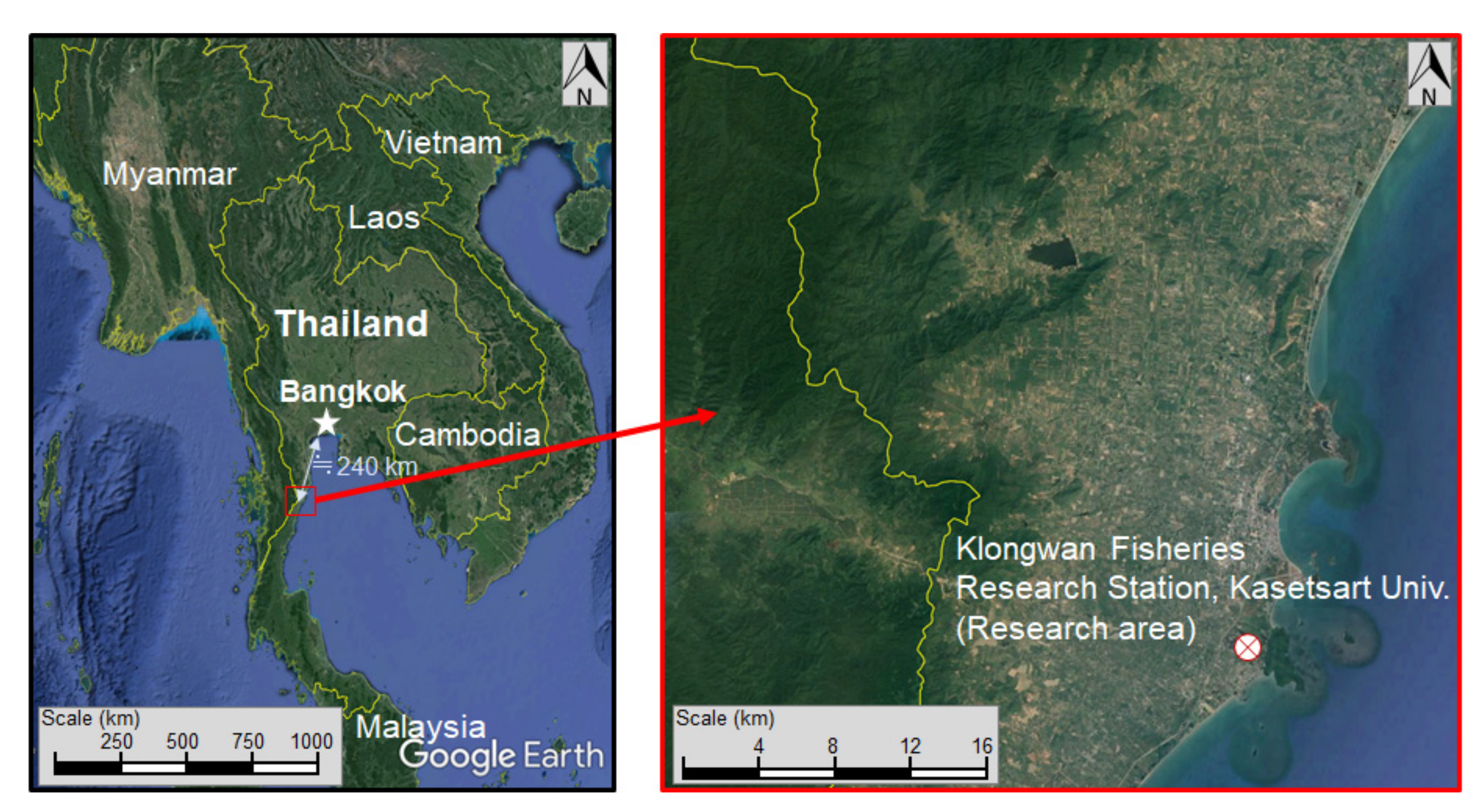
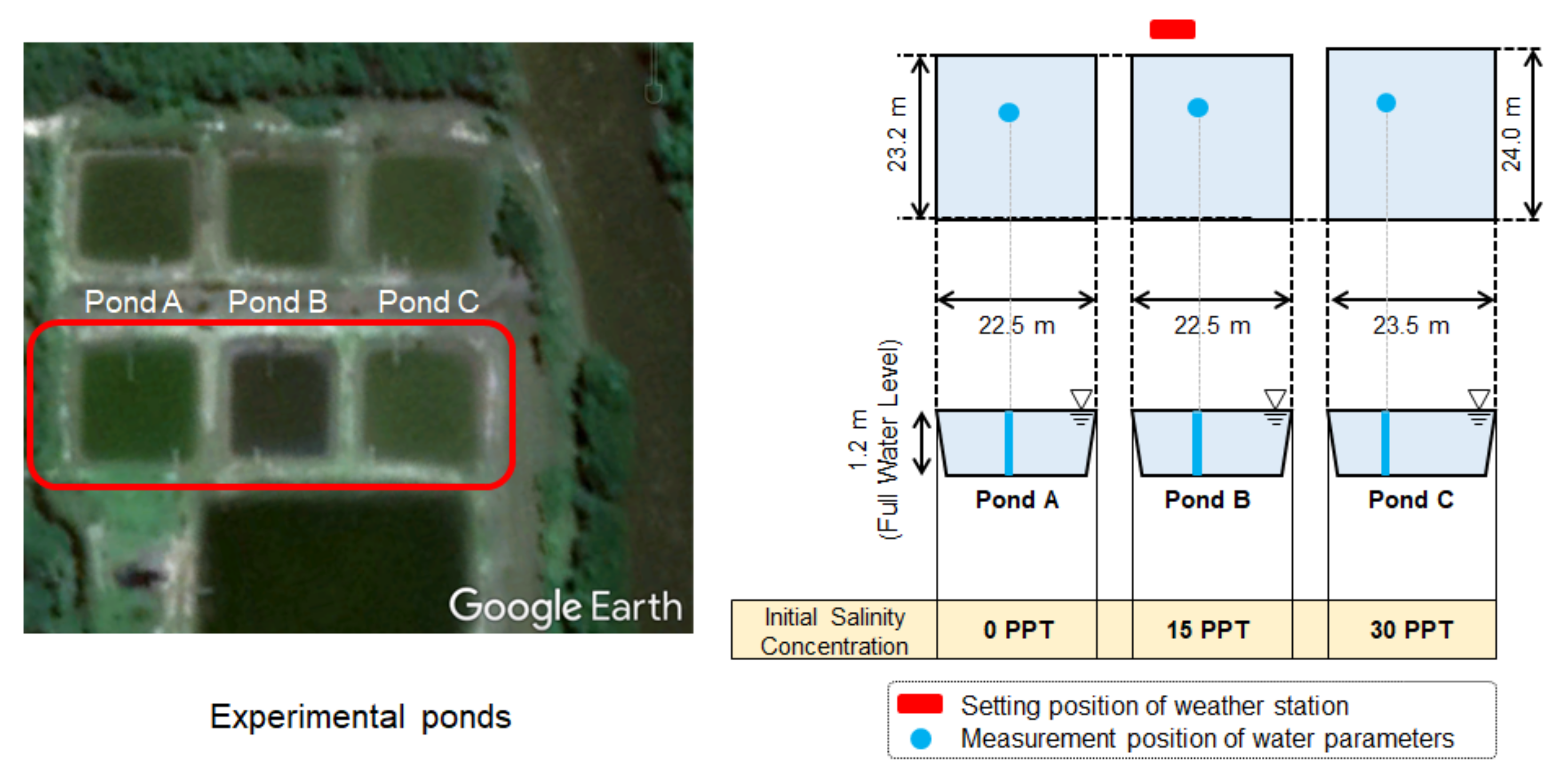
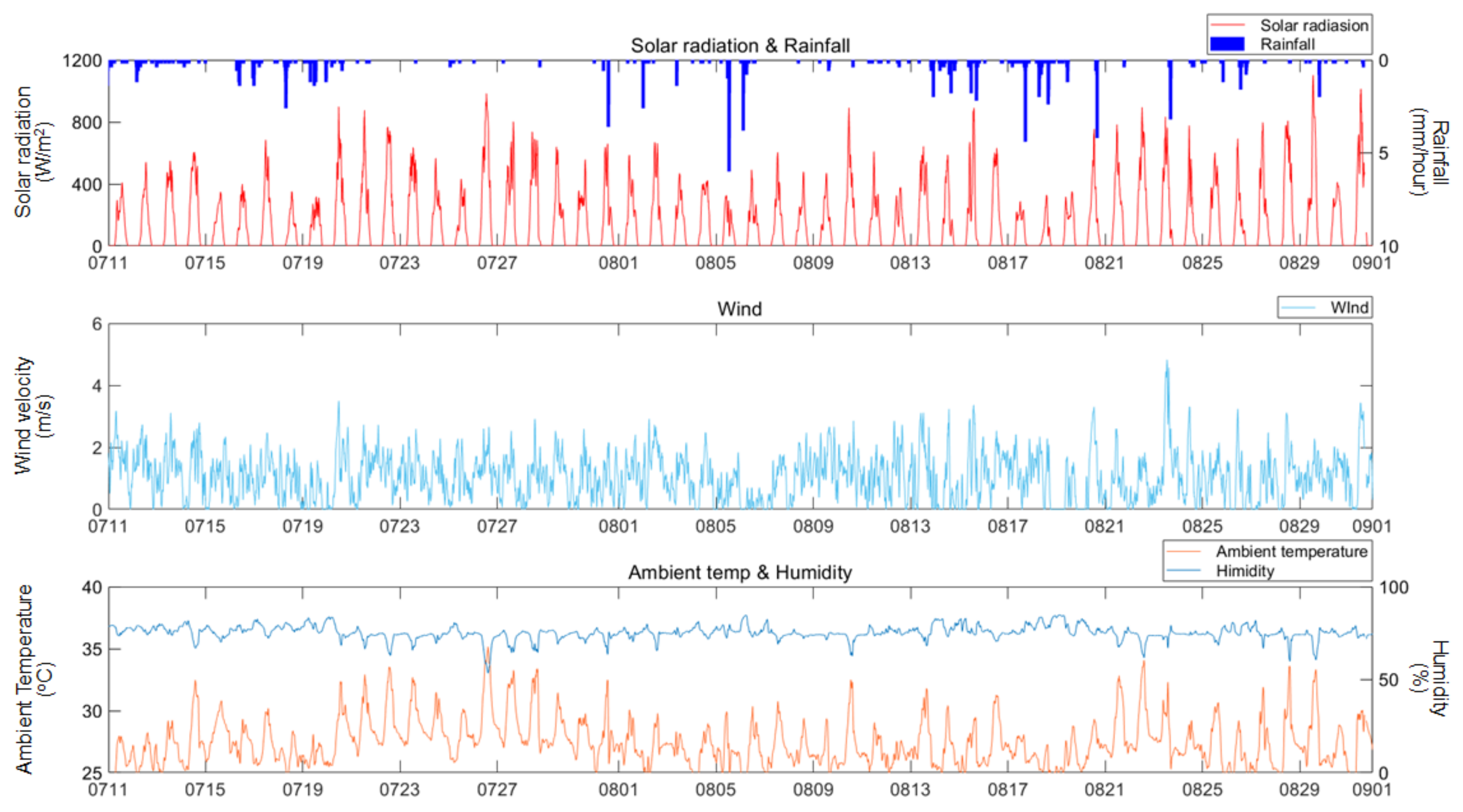
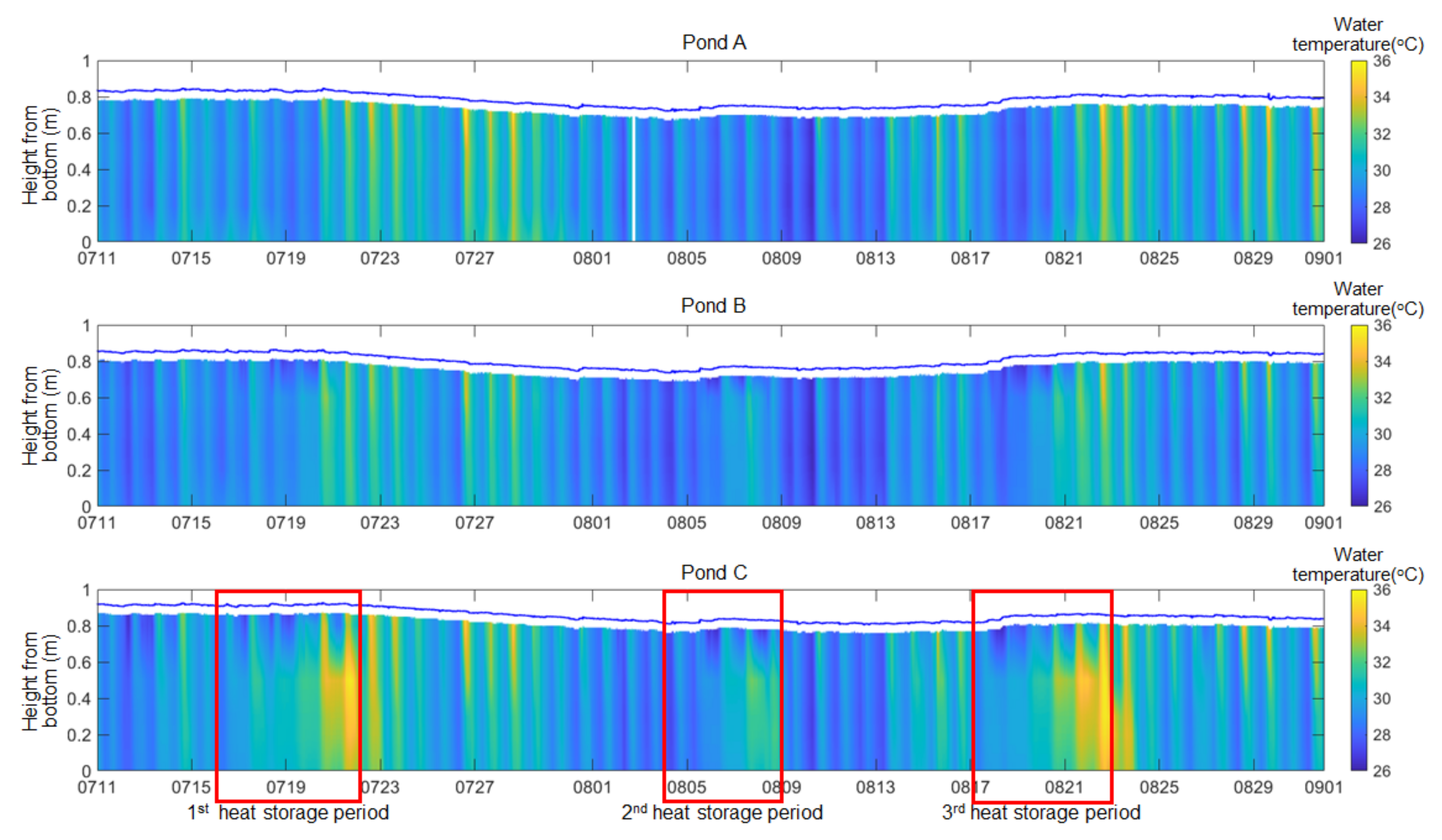
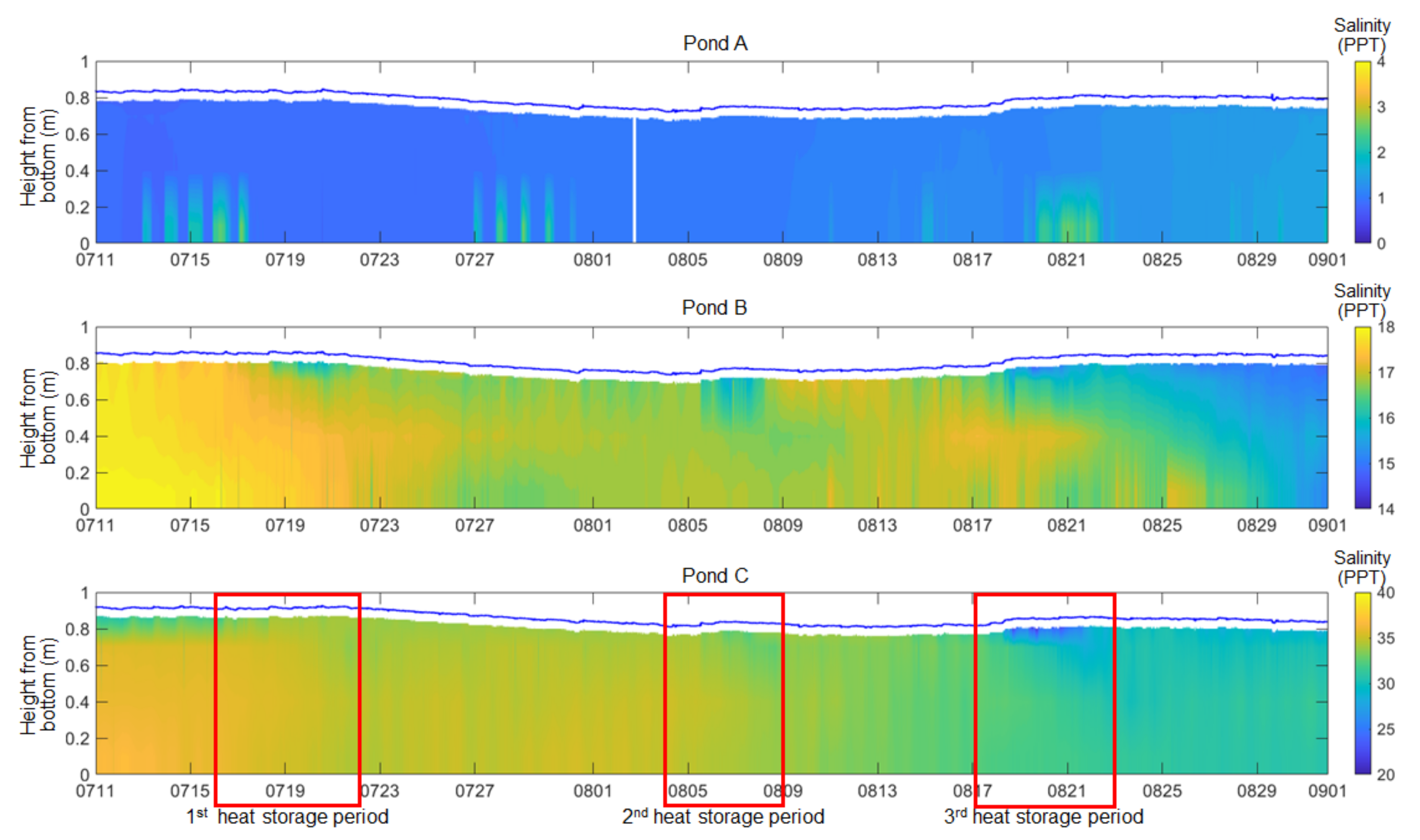
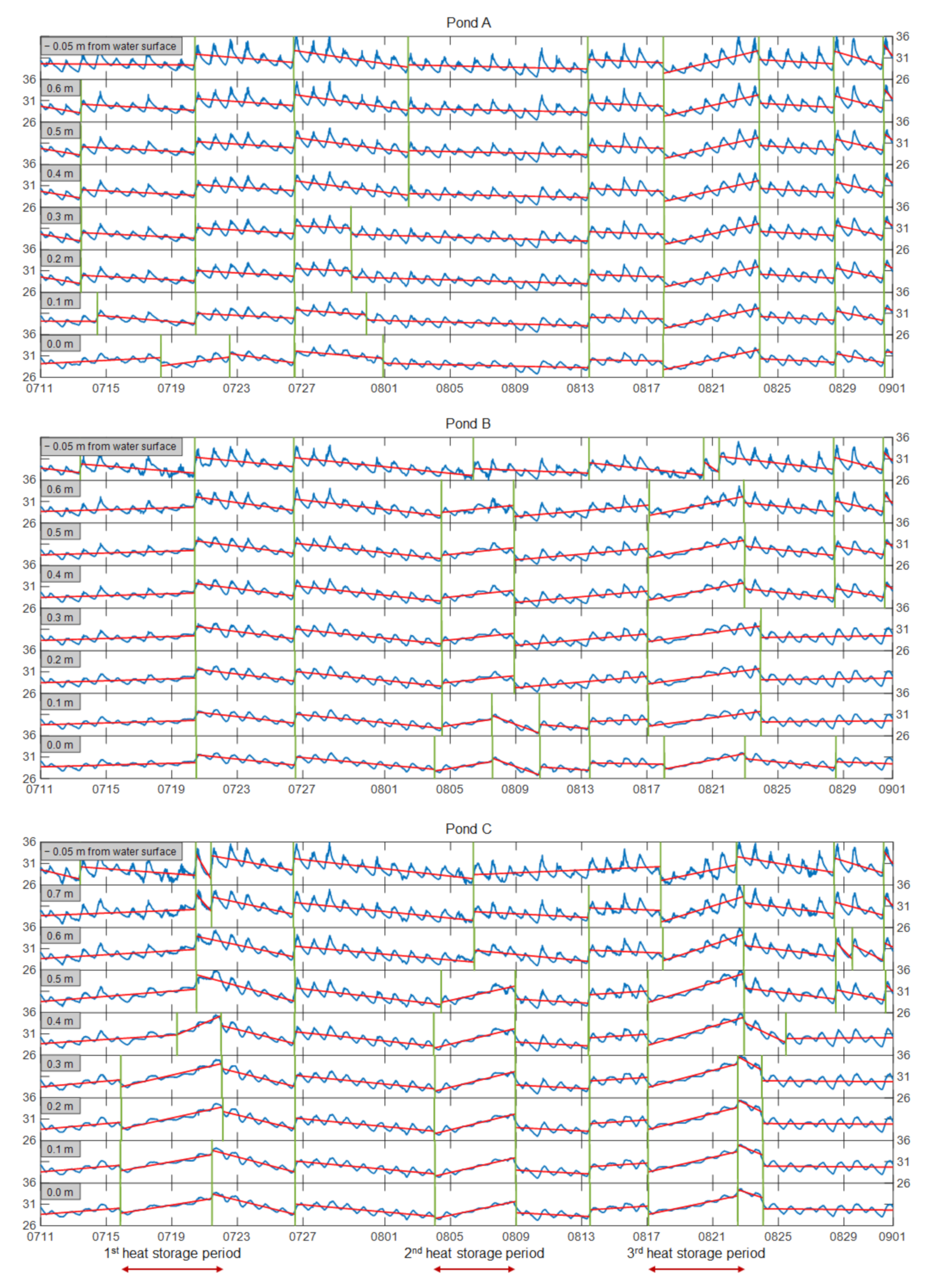
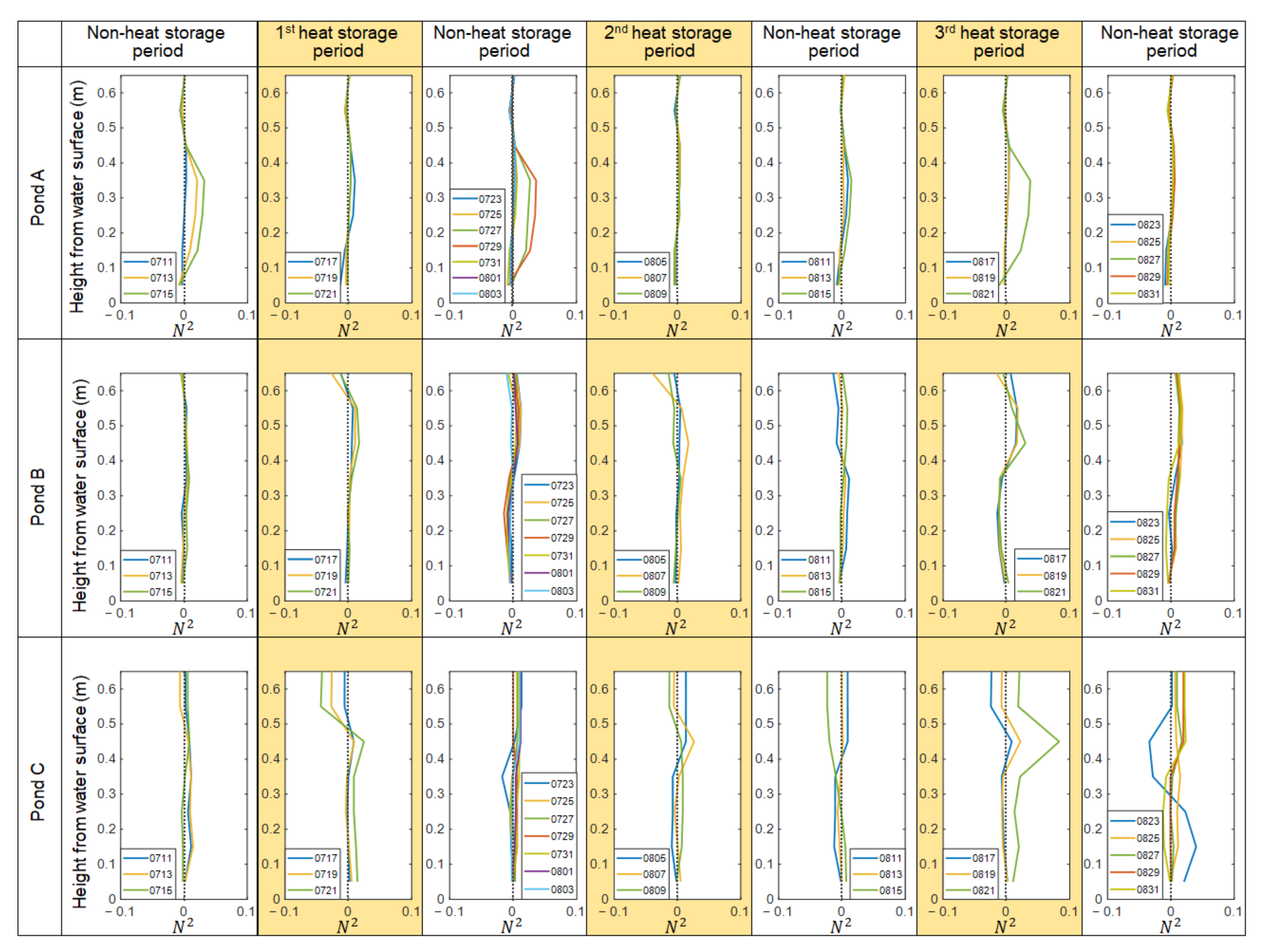
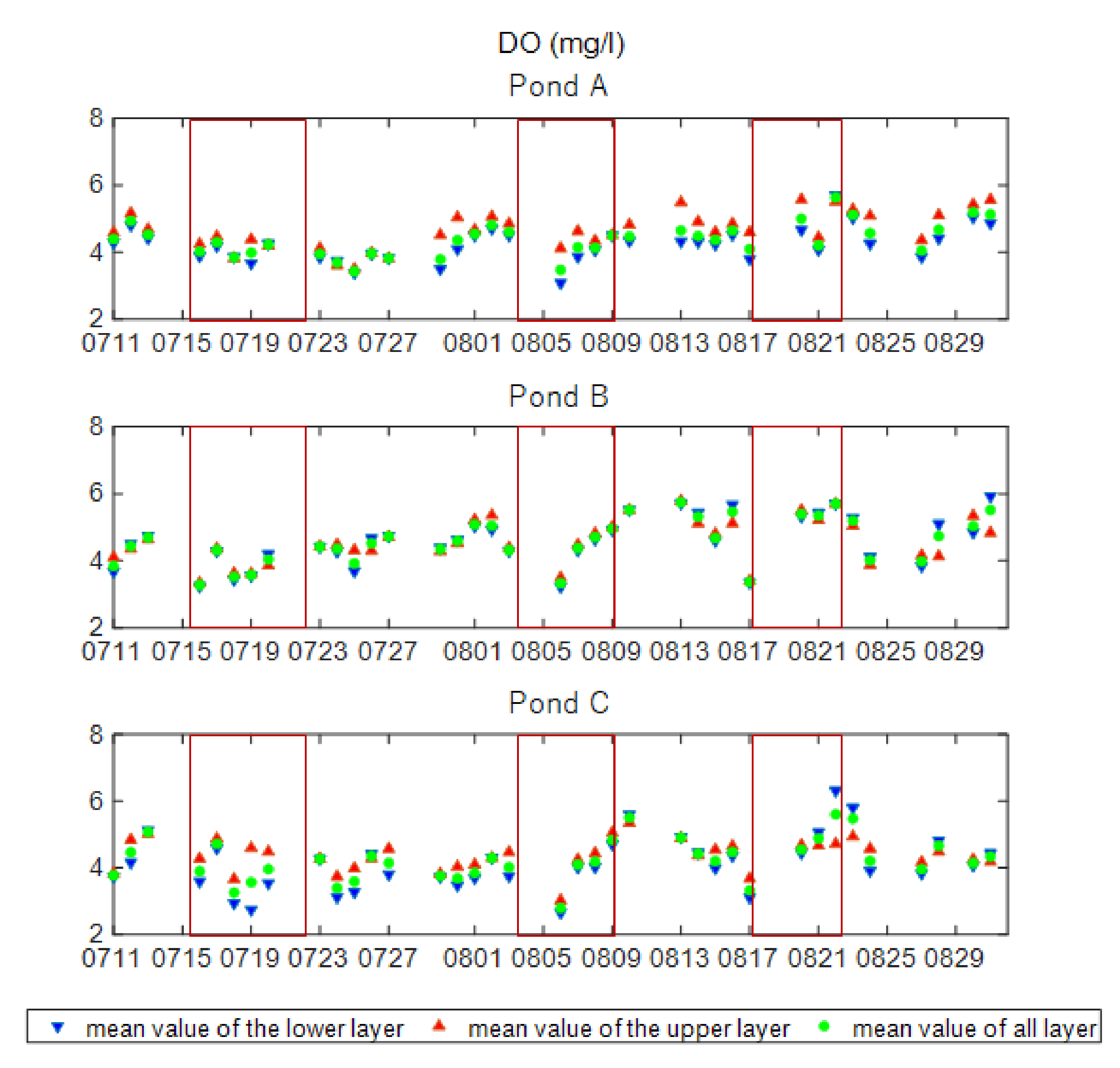
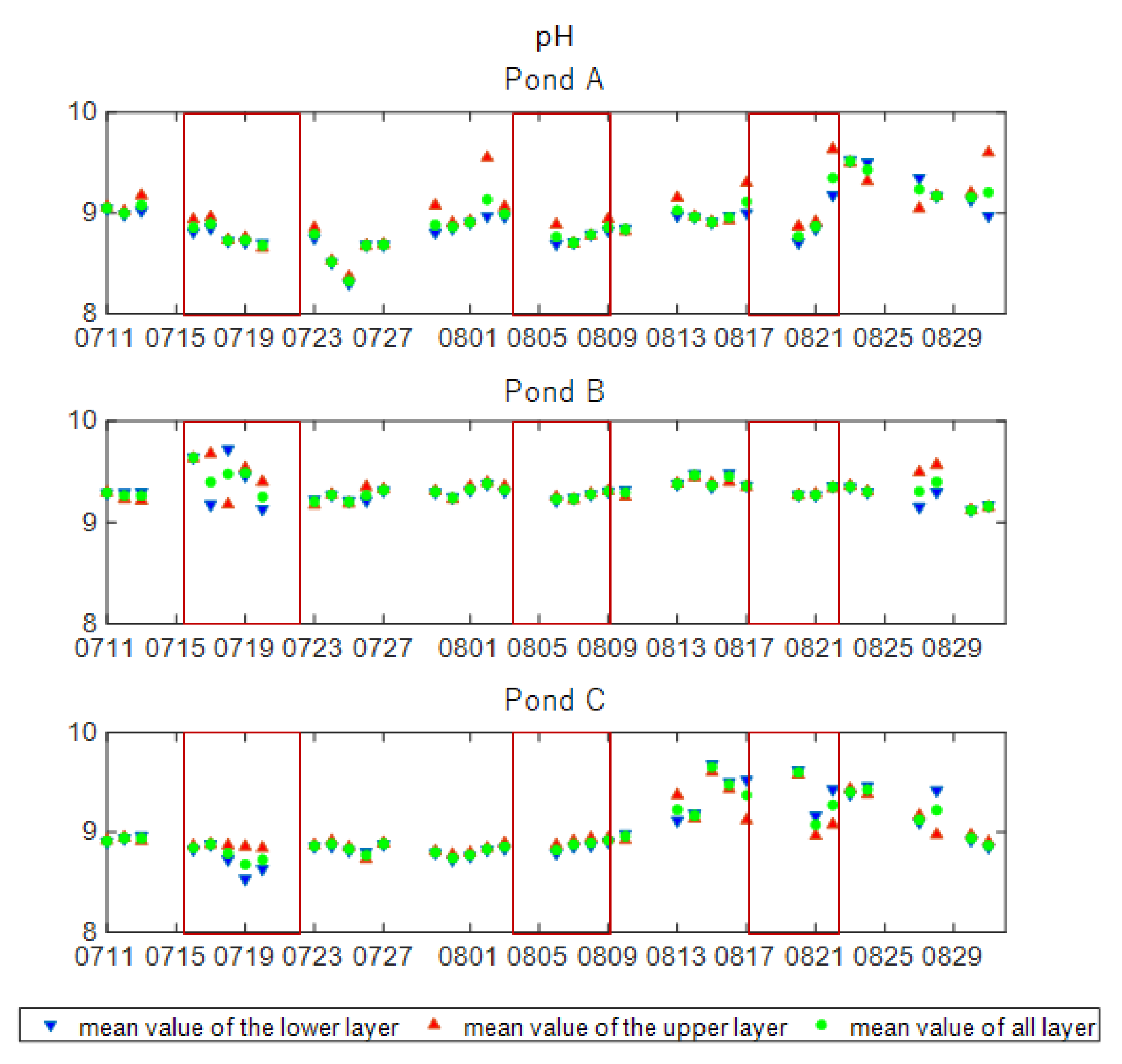
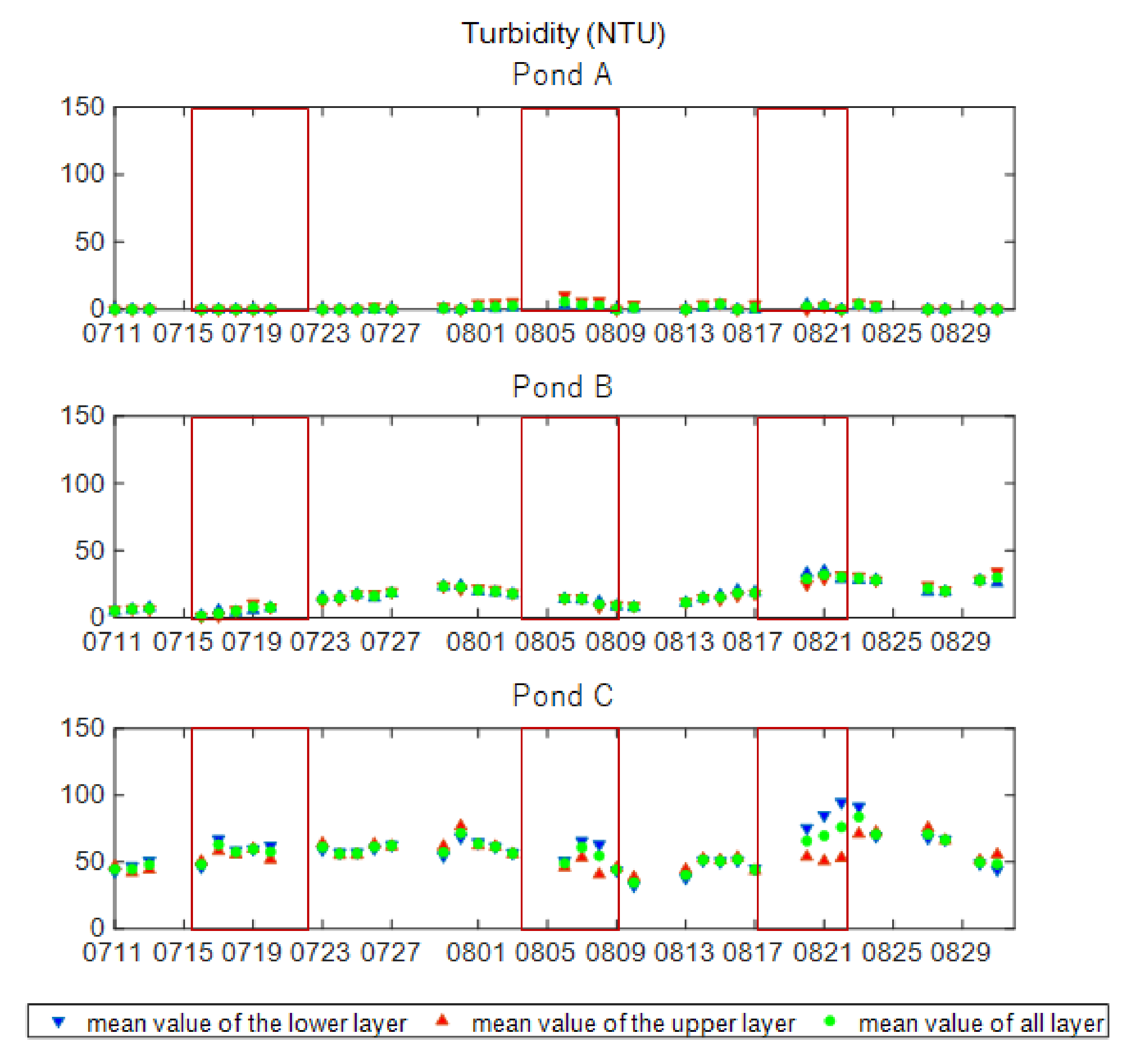
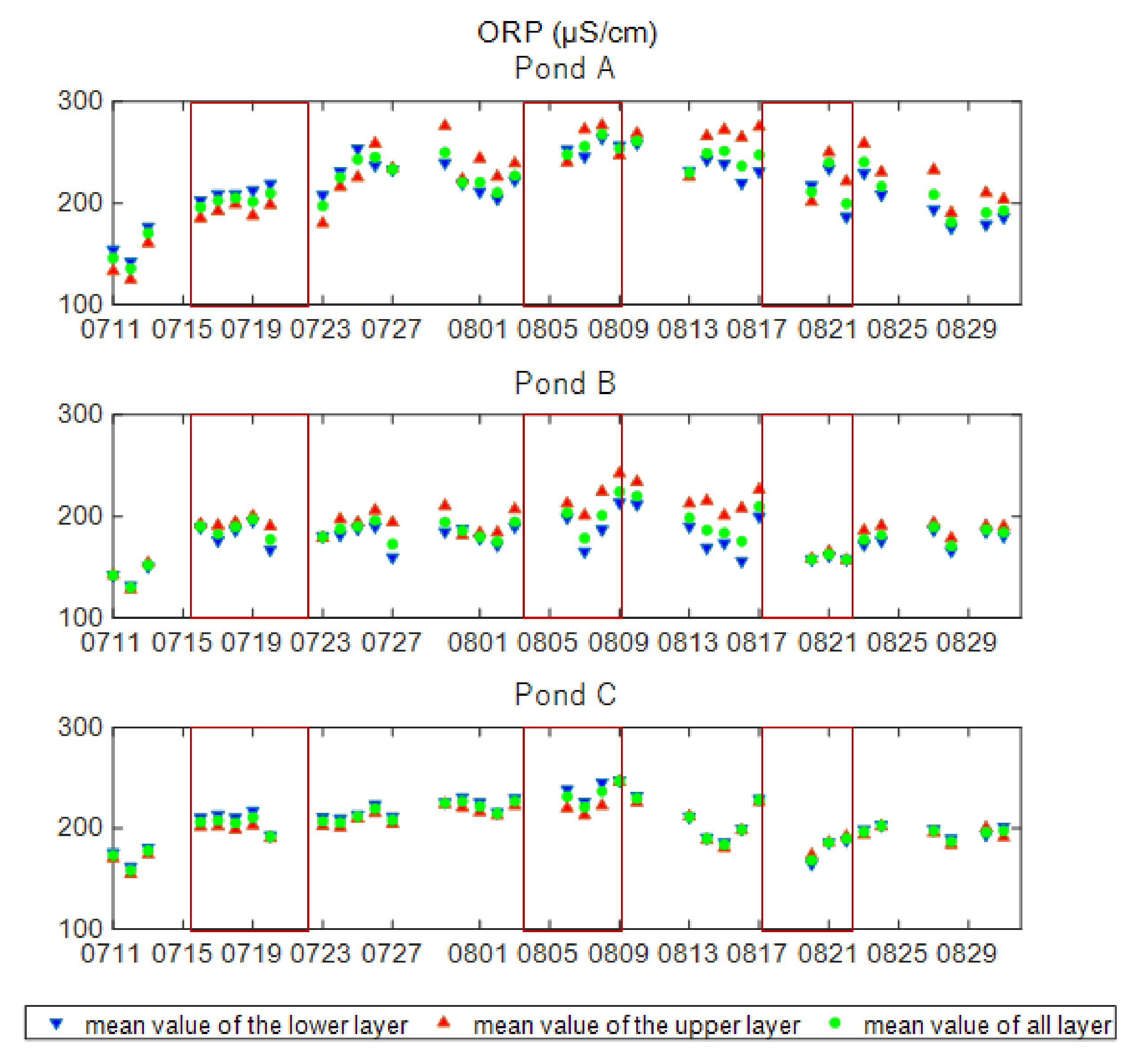
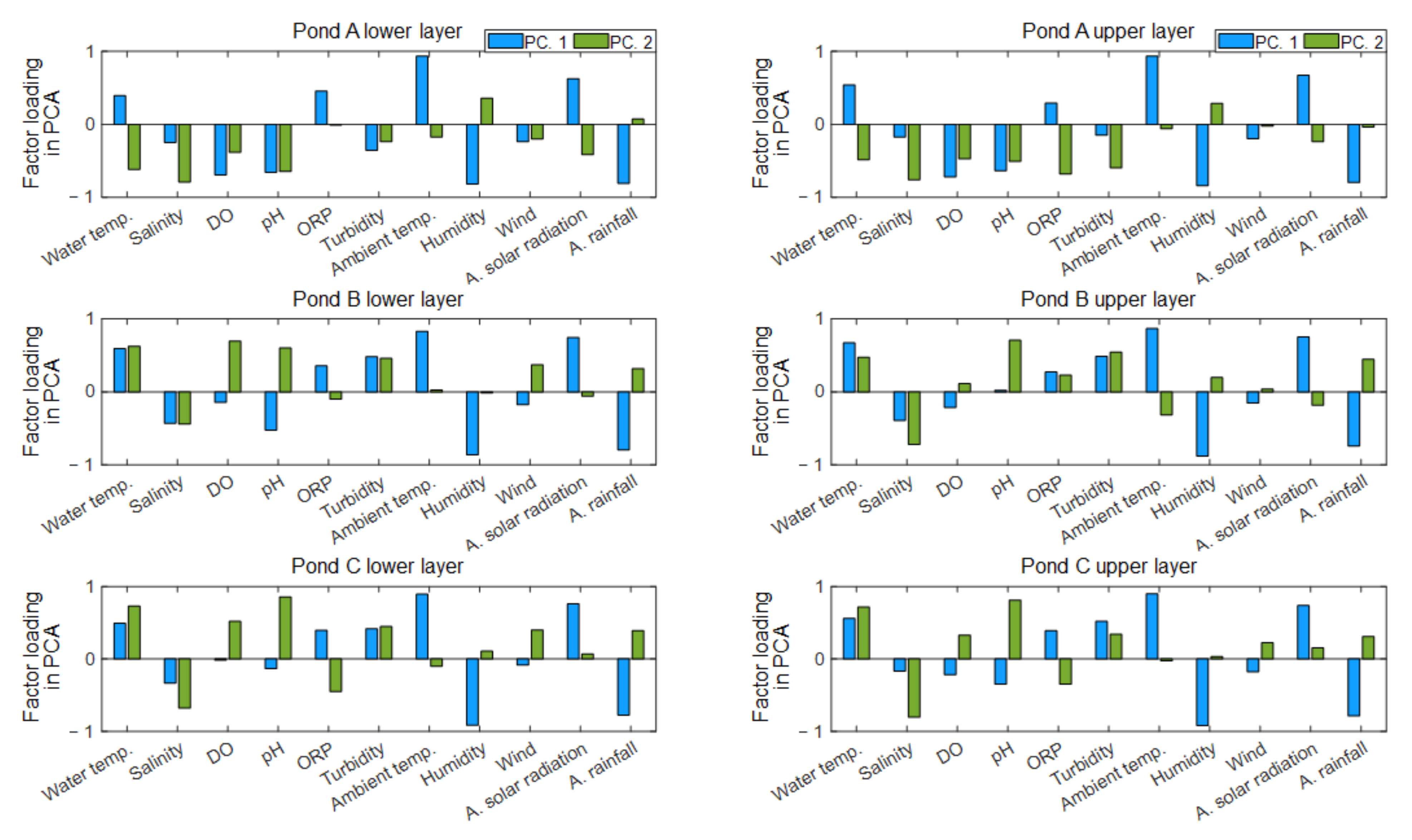
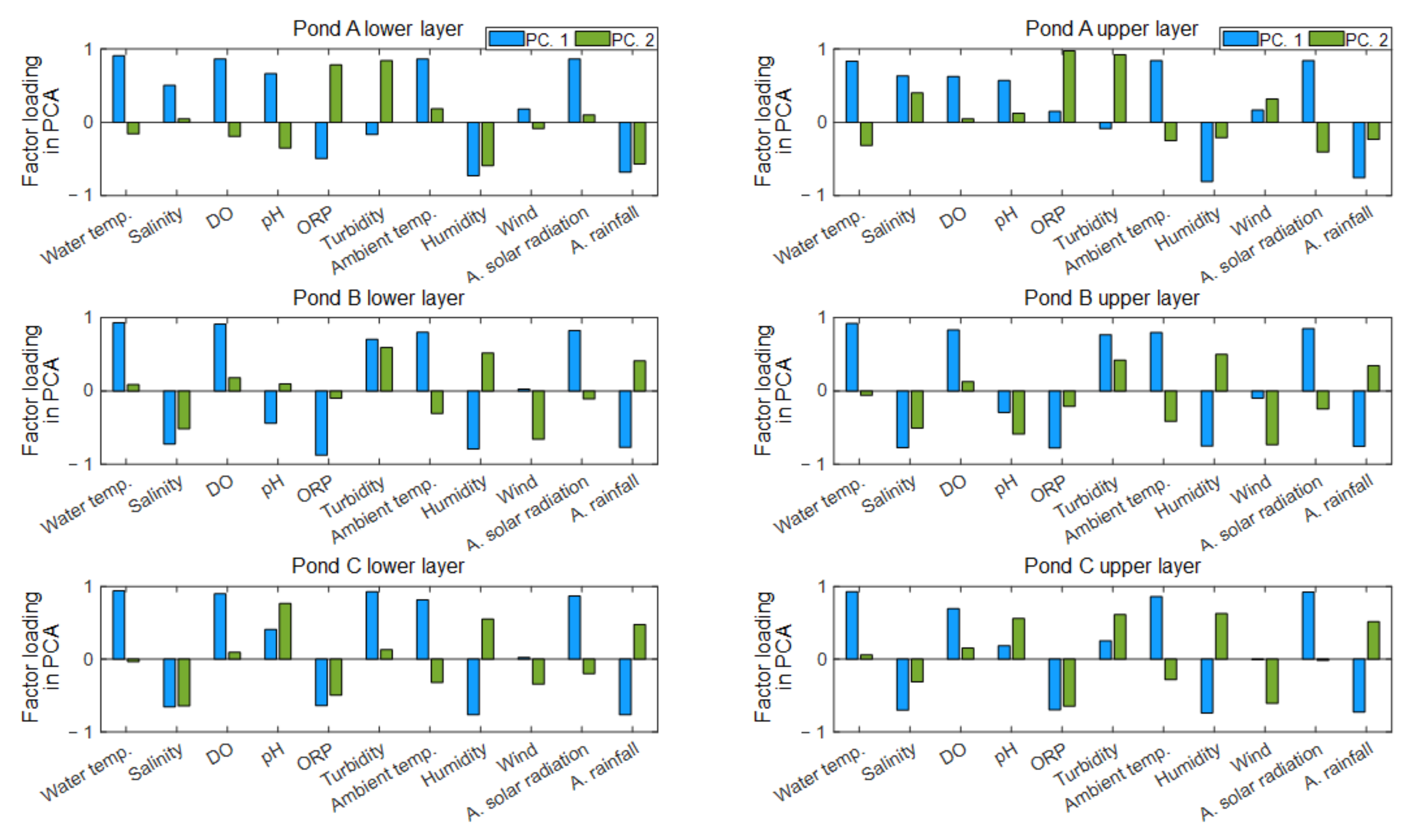
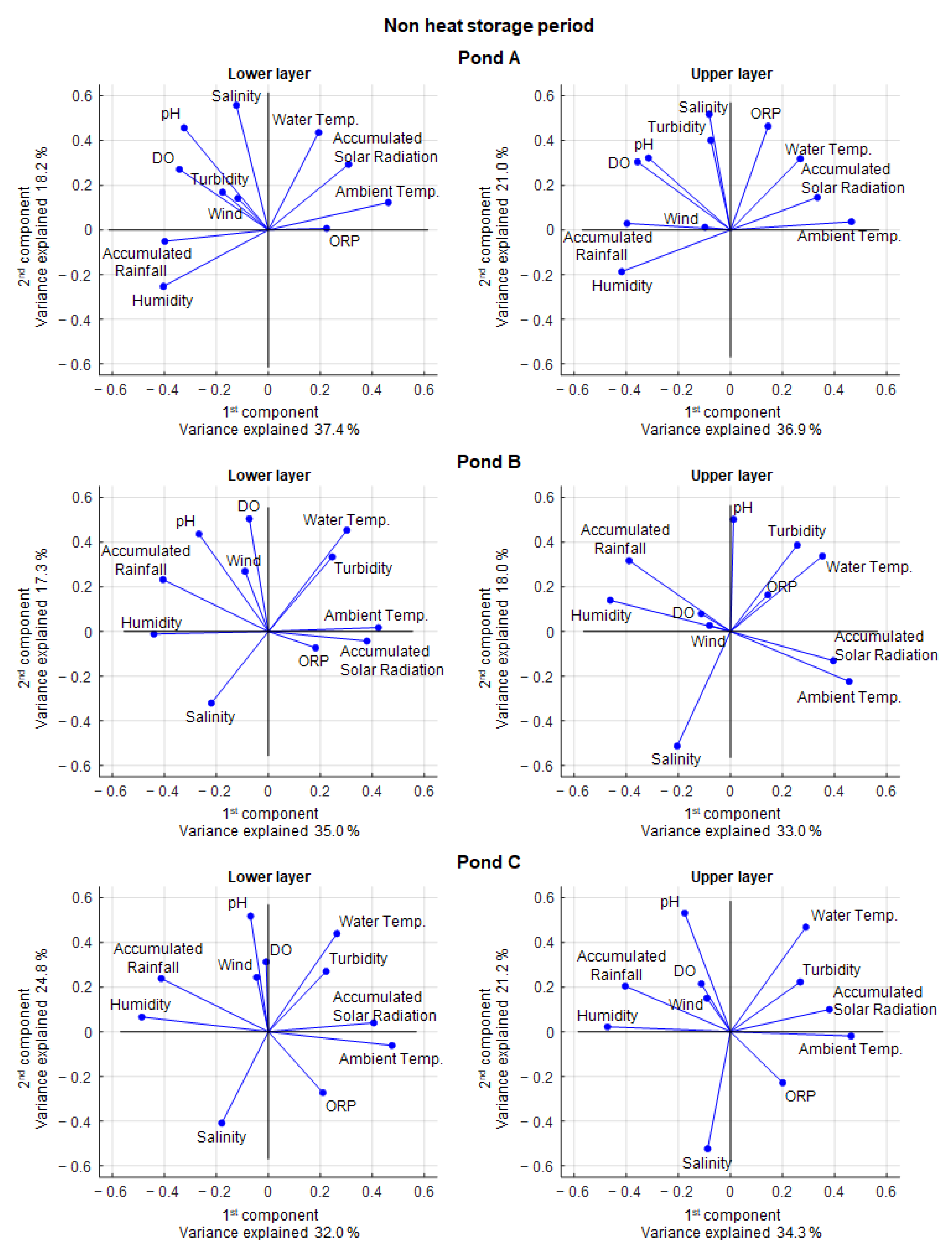
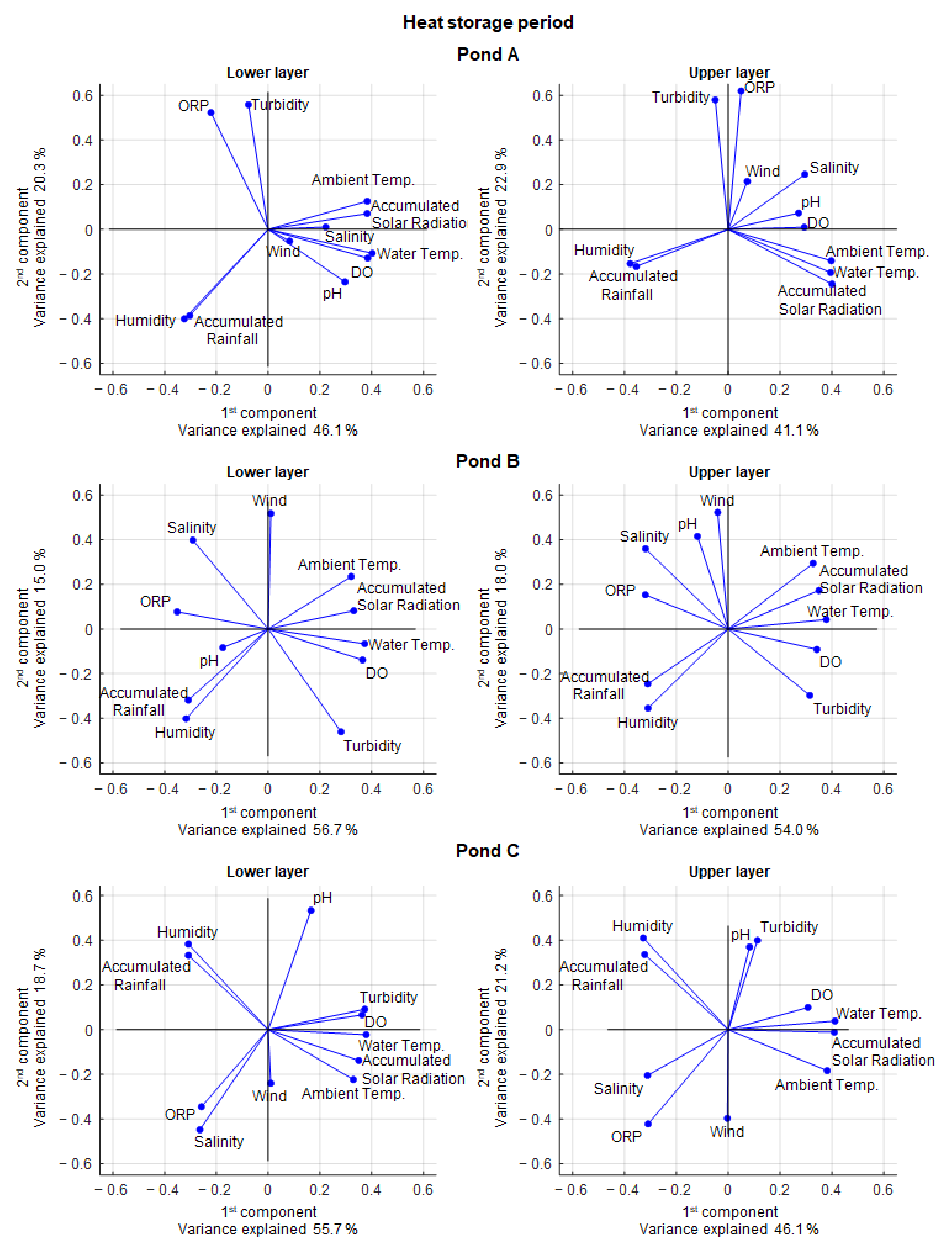
| Measurement Parameters | Unit | Equipment | Accuracies | Height | Measurement Interval | |
|---|---|---|---|---|---|---|
| Weather variation | Ambient temperature | °C | Onset S-THB-M008 | ±0.21 from 0 °C to 50 °C | 1 m above ground level | 10 min with 4-channel data logger (Onset U12-008) × 2 |
| Humidity | % | ±2.5% from 10% to 90% | ||||
| Wind velocity | m/s | Onset S-WSB-M003 | ±1.1 m/s | 2 m above ground level | ||
| Wind direction | Deg * | Onset S-WDA-M003 | ±5 degrees | |||
| Solar radiation | W/m2 | Onset S-LIB-M003 | ±10 W/m2 | 1 m above ground level | ||
| Rainfall amount | mm | Onset S-RGB-M002 | ±1.0% at up to 20 mm | |||
| Ambient pressure | hPa | Onset S-BPB-CM050 | ±3.0 hPa | |||
| Water parameter (auto) | Water temperature | °C | Onset UA-002-64 | ±0.53 °C from 0 °C to 50 °C | 0.0 m, 0.2 m, 0.3 m, 0.5 m, 0.6 m, 0.8 m from the bottom and 0.05 m below from water surface | 10 min with built-in memory |
| Electric conductivity | μS/cm | Onset HOBO U24 | ±20 μS/cm | 0.1 m, 0.4 m, 0.7 m from the bottom and 0.05 m below from water surface | ||
| Pressure at bottom | kPa | Onset HOBO U20 | ±0.3% full scale | bottom | ||
| Water parameter (manual) | Water temperature | °C | HORIBA U-50 | ±0.1 °C | 0.1 m interval from bottom to the water surface | 5 times per week (12:00–14:00), manual measurement |
| Salinity | PPT ** | ±3 PPT | ||||
| Dissolved Oxygen | mg/L | ±0.2 mg/L | ||||
| pH | - | ±0.1 | ||||
| Turbidity | NTU | ±1.0 NTU | ||||
| ORP | mv | ±1% full scale | ||||
| Height from Bottom (m) | 1st Heat Storage Period | 2nd Heat Storage Period | 3rd Heat Storage Period | |||
|---|---|---|---|---|---|---|
| Start | End | Start | End | Start | End | |
| 0.5 | --- | --- | 0804 10:30 | 0808 22:20 | 0817 00:50 | 0822 21:30 |
| 0.4 | 0719 07:10 | 0721 23:20 | 0803 23:50 | 0808 22:40 | 0817 01:00 | 0822 21:30 |
| 0.3 | 0715 21:00 | 0722 01:30 | 0804 00:50 | 0808 22:40 | 0817 01:00 | 0822 12:10 |
| 0.2 | 0715 21:20 | 0722 02:30 | 0804 00:10 | 0808 22:50 | 0817 01:00 | 0822 12:10 |
| 0.1 | 0715 20:50 | 0721 10:50 | 0804 01:20 | 0808 23:23 | 0817 01:20 | 0822 12:00 |
| 0 | 0715 21:00 | 0721 11:00 | 0804 01:30 | 0809 00:10 | 0817 01:40 | 0822 11:40 |
| Defined | 0715 20:50 | 0722 01:30 | 0803 23:50 | 0809 00:10 | 0817 00:50 | 0822 21:30 |
| Non-Heat Storage Period | Heat Storage Period | ||||||||||
|---|---|---|---|---|---|---|---|---|---|---|---|
| n = 24 | Amb. Temp. | Humidity | Accum. S.R | Accum. Rainfall | Wind | n = 12 | Amb. Temp. | Humidity | Accum. S.R | Accum. Rainfall | Wind |
| (°C) | (%) | (W/m2) | (mm) | (m/s) | (°C) | (%) | (W/m2) | (mm) | (m/s) | ||
| Mean | 27.49 | 74.71 | 21,042.79 | 3.02 | 1.16 | Mean | 27.38 | 76.08 | 17,822.21 | 6.18 | 0.93 |
| Std. Dev | 1.07 | 2.03 | 4511.11 | 2.90 | 0.25 | Std. Dev | 1.08 | 2.66 | 6459.55 | 7.72 | 0.26 |
| Min | 26.05 | 69.26 | 12,922.70 | 0.00 | 0.78 | Min | 26.24 | 71.87 | 7229.70 | 0.00 | 0.54 |
| Max | 30.22 | 78.28 | 32,735.90 | 10.80 | 1.75 | Max | 29.18 | 79.54 | 32,032.50 | 26.60 | 1.31 |
| p-value | 0.034 | 0.709 | 0.718 | 0.006 | 0.396 | p-value | 0.014 | 0.293 | 0.624 | 0.006 | 0.265 |
| Pond A | |||||||||||||||
|---|---|---|---|---|---|---|---|---|---|---|---|---|---|---|---|
| Non-Heat Storage Period | Heat Storage Period | ||||||||||||||
| n = 24 | W.T. | Sal. | DO | Turb. | ORP | pH | n = 12 | W.T. | Sal. | DO | Turb. | ORP | pH | ||
| (°C) | (PPT) | (mg/L) | (NTU) | (mv) | - | (°C) | (PPT) | (mg/L) | (NTU) | (mv) | - | ||||
| Up | Mean | 31.16 | 1.17 | 4.67 | 1.62 | 225.32 | 8.99 | Up | Mean | 30.75 | 1.13 | 4.53 | 2.41 | 224.95 | 8.93 |
| Std. Dev | 0.87 | 0.20 | 0.54 | 2.08 | 41.53 | 0.27 | Std. Dev | 1.08 | 0.15 | 0.52 | 3.45 | 36.02 | 0.28 | ||
| Min | 29.43 | 0.90 | 3.50 | 0.00 | 124.67 | 8.37 | Min | 29.44 | 1.00 | 3.83 | 0.00 | 185.33 | 8.66 | ||
| Max | 32.46 | 1.60 | 5.49 | 5.45 | 276.00 | 9.55 | Max | 32.94 | 1.40 | 5.57 | 10.27 | 276.50 | 9.63 | ||
| p-value | 0.435 | 0.068 | 0.226 | 3 × 10−5 | 0.015 | 0.771 | p-value | 0.204 | 0.011 | 0.032 | 0.003 | 0.041 | 0.009 | ||
| Low | Mean | 31.08 | 1.17 | 4.27 | 0.64 | 215.13 | 8.94 | Low | Mean | 30.63 | 1.22 | 4.09 | 1.11 | 223.47 | 8.81 |
| Std. Dev | 0.84 | 0.19 | 0.43 | 1.02 | 31.39 | 0.28 | Std. Dev | 0.86 | 0.21 | 0.63 | 1.43 | 22.52 | 0.15 | ||
| Min | 29.34 | 0.90 | 3.39 | 0.00 | 142.20 | 8.30 | Min | 29.60 | 1.00 | 3.09 | 0.00 | 186.40 | 8.69 | ||
| Max | 32.65 | 1.60 | 5.05 | 3.38 | 258.40 | 9.52 | Max | 32.50 | 1.62 | 5.70 | 3.60 | 264.00 | 9.18 | ||
| p-value | 0.955 | 0.083 | 0.698 | 7 × 10−6 | 0.127 | 0.297 | p-value | 0.270 | 0.139 | 0.055 | 0.003 | 0.908 | 0.006 | ||
| Pond B | |||||||||||||||
| Non heat storage period | Heat storage period | ||||||||||||||
| n= 24 | W.T. | Sal. | DO | Turb. | ORP | pH | n= 12 | W.T. | Sal. | DO | Turb. | ORP | pH | ||
| (°C) | (PPT) | (mg/L) | (NTU) | (mv) | - | (°C) | (PPT) | (mg/L) | (NTU) | (mv) | - | ||||
| Up | Mean | 30.90 | 16.95 | 4.71 | 16.92 | 192.22 | 9.32 | Up | Mean | 31.03 | 16.51 | 4.28 | 13.04 | 192.74 | 9.37 |
| Std. Dev | 0.95 | 0.78 | 0.51 | 7.14 | 25.57 | 0.10 | Std. Dev | 1.22 | 0.74 | 0.85 | 9.80 | 23.15 | 0.16 | ||
| Min | 29.28 | 15.48 | 3.88 | 6.00 | 128.25 | 9.12 | Min | 29.61 | 15.23 | 3.34 | 0.75 | 157.00 | 9.18 | ||
| Max | 32.38 | 18.10 | 5.79 | 31.33 | 242.33 | 9.57 | Max | 33.27 | 17.53 | 5.69 | 32.47 | 226.33 | 9.68 | ||
| p-value | 0.358 | 0.013 | 0.347 | 0.689 | 0.211 | 0.973 | p-value | 0.181 | 0.123 | 0.128 | 0.633 | 0.306 | 0.081 | ||
| Low | Mean | 30.70 | 17.00 | 4.71 | 16.85 | 176.42 | 9.30 | Low | Mean | 31.06 | 16.92 | 4.23 | 15.15 | 178.33 | 9.34 |
| Std. Dev | 0.80 | 0.80 | 0.57 | 6.75 | 19.15 | 0.08 | Std. Dev | 1.00 | 0.73 | 0.89 | 11.70 | 16.09 | 0.18 | ||
| Min | 29.38 | 15.44 | 3.68 | 4.62 | 131.80 | 9.12 | Min | 29.98 | 15.58 | 3.23 | 1.34 | 157.60 | 9.13 | ||
| Max | 32.36 | 18.12 | 5.71 | 28.38 | 213.40 | 9.48 | Max | 32.52 | 17.66 | 5.70 | 35.42 | 199.60 | 9.72 | ||
| p-value | 0.704 | 0.005 | 0.751 | 0.440 | 0.395 | 0.201 | p-value | 0.034 | 0.050 | 0.132 | 0.129 | 0.136 | 0.077 | ||
| Pond C | |||||||||||||||
| Non-heat storage period | Heat storage period | ||||||||||||||
| n= 24 | W.T. | Sal. | DO | Turb. | ORP | pH | n= 12 | W.T. | Sal. | DO | Turb. | ORP | pH | ||
| (°C) | (PPT) | (mg/L) | (NTU) | (mv) | - | (°C) | (PPT) | (mg/L) | (NTU) | (mv) | - | ||||
| Up | Mean | 31.75 | 30.63 | 4.44 | 57.34 | 202.25 | 9.02 | Up | Mean | 32.13 | 30.31 | 4.28 | 51.53 | 202.32 | 8.98 |
| Std. Dev | 1.19 | 1.66 | 0.42 | 10.77 | 20.32 | 0.24 | Std. Dev | 1.44 | 1.74 | 0.55 | 5.71 | 15.84 | 0.21 | ||
| Min | 29.82 | 26.07 | 3.74 | 38.67 | 154.75 | 8.73 | Min | 30.38 | 27.33 | 3.02 | 40.73 | 173.25 | 8.84 | ||
| Max | 33.81 | 33.08 | 5.35 | 76.97 | 246.33 | 9.60 | Max | 34.38 | 31.73 | 4.88 | 60.05 | 226.00 | 9.58 | ||
| p-value | 0.319 | 0.002 | 0.821 | 0.637 | 0.960 | 0.001 | p-value | 0.202 | 0.002 | 0.050 | 0.763 | 0.847 | 0.004 | ||
| Low | Mean | 31.31 | 30.83 | 4.22 | 56.41 | 206.73 | 9.02 | Low | Mean | 32.49 | 31.33 | 3.92 | 64.49 | 210.03 | 8.99 |
| Std. Dev | 1.00 | 1.48 | 0.68 | 12.32 | 20.43 | 0.27 | Std. Dev | 1.64 | 0.93 | 1.07 | 14.84 | 23.69 | 0.36 | ||
| Min | 29.82 | 28.20 | 3.12 | 32.32 | 161.60 | 8.72 | Min | 30.29 | 29.86 | 2.66 | 45.08 | 164.60 | 8.53 | ||
| Max | 34.27 | 33.12 | 5.80 | 91.50 | 247.20 | 9.68 | Max | 35.74 | 32.20 | 6.31 | 94.72 | 245.20 | 9.62 | ||
| p-value | 0.125 | 0.034 | 0.343 | 0.456 | 0.985 | 0.002 | p-value | 0.73 | 0.00 | 0.40 | 0.51 | 0.90 | 0.10 | ||
| Pond A | ||||||||||||||||||||
|---|---|---|---|---|---|---|---|---|---|---|---|---|---|---|---|---|---|---|---|---|
| Period | Non Heat Storage Period | Heat Storage Period | ||||||||||||||||||
| Layer | Lower Layer | Upper layer | Lower layer | Upper layer | ||||||||||||||||
| PC | 1 | 2 | 3 | 4 | 5 | 1 | 2 | 3 | 4 | 5 | 1 | 2 | 3 | 4 | 5 | 1 | 2 | 3 | 4 | 5 |
| VE (%) | 37.4 | 18.2 | 12.9 | 10.4 | 7.2 | 36.9 | 20.6 | 11.6 | 9.4 | 7.9 | 46.1 | 20.3 | 13.4 | 10.9 | 3.9 | 41.1 | 22.8 | 16.4 | 9.4 | 5.2 |
| CVE (%) | 37.4 | 55.6 | 68.5 | 78.9 | 86.1 | 36.9 | 57.5 | 69.1 | 78.5 | 86.4 | 46.1 | 66.4 | 79.8 | 90.7 | 94.6 | 41.1 | 63.9 | 80.3 | 89.7 | 94.9 |
| Pond B | ||||||||||||||||||||
| Period | Non heat storage period | Heat storage period | ||||||||||||||||||
| Layer | Lower layer | Upper layer | Lower layer | Upper layer | ||||||||||||||||
| PC | 1 | 2 | 3 | 4 | 5 | 1 | 2 | 3 | 4 | 5 | 1 | 2 | 3 | 4 | 5 | 1 | 2 | 3 | 4 | 5 |
| VE (%) | 35.0 | 17.3 | 14.0 | 10.4 | 8.7 | 33.0 | 18.0 | 13.0 | 10.9 | 7.9 | 56.7 | 15.0 | 10.8 | 7.1 | 4.2 | 54.0 | 18.0 | 12.0 | 7.4 | 3.8 |
| CVE (%) | 35.0 | 52.3 | 66.3 | 76.6 | 85.4 | 33.0 | 51.0 | 64.0 | 74.9 | 82.8 | 56.7 | 71.7 | 82.5 | 89.6 | 93.8 | 54.0 | 72.0 | 84.0 | 91.4 | 95.2 |
| Pond C | ||||||||||||||||||||
| Period | Non heat storage period | Heat storage period | ||||||||||||||||||
| Layer | Lower layer | Upper layer | Lower layer | Upper layer | ||||||||||||||||
| PC | 1 | 2 | 3 | 4 | 5 | 1 | 2 | 3 | 4 | 5 | 1 | 2 | 3 | 4 | 5 | 1 | 2 | 3 | 4 | 5 |
| VE (%) | 32.0 | 24.9 | 12.1 | 9.1 | 7.8 | 34.3 | 21.2 | 13.6 | 9.0 | 8.8 | 55.7 | 18.7 | 12.5 | 5.2 | 3.4 | 46.1 | 21.2 | 13.3 | 10.3 | 3.5 |
| CVE (%) | 32.0 | 56.9 | 68.9 | 78.1 | 85.8 | 34.3 | 55.5 | 69.1 | 78.1 | 86.8 | 55.7 | 74.4 | 87.0 | 92.2 | 95.5 | 46.1 | 67.3 | 80.6 | 90.9 | 94.4 |
Publisher’s Note: MDPI stays neutral with regard to jurisdictional claims in published maps and institutional affiliations. |
© 2021 by the authors. Licensee MDPI, Basel, Switzerland. This article is an open access article distributed under the terms and conditions of the Creative Commons Attribution (CC BY) license (https://creativecommons.org/licenses/by/4.0/).
Share and Cite
Ozaki, A.; Kaewjantawee, P.; Nguyen Van, T.; Matsumoto, M. Halocline Induced by Rainfall in Saline Water Ponds in the Tropics and Its Impact on Physical Water Quality. Water 2021, 13, 1889. https://doi.org/10.3390/w13141889
Ozaki A, Kaewjantawee P, Nguyen Van T, Matsumoto M. Halocline Induced by Rainfall in Saline Water Ponds in the Tropics and Its Impact on Physical Water Quality. Water. 2021; 13(14):1889. https://doi.org/10.3390/w13141889
Chicago/Turabian StyleOzaki, Akinori, Panitan Kaewjantawee, Thinh Nguyen Van, and Masaru Matsumoto. 2021. "Halocline Induced by Rainfall in Saline Water Ponds in the Tropics and Its Impact on Physical Water Quality" Water 13, no. 14: 1889. https://doi.org/10.3390/w13141889
APA StyleOzaki, A., Kaewjantawee, P., Nguyen Van, T., & Matsumoto, M. (2021). Halocline Induced by Rainfall in Saline Water Ponds in the Tropics and Its Impact on Physical Water Quality. Water, 13(14), 1889. https://doi.org/10.3390/w13141889






